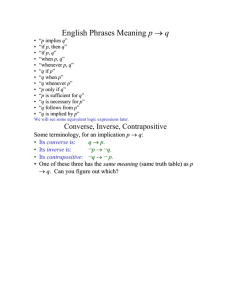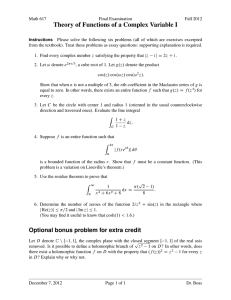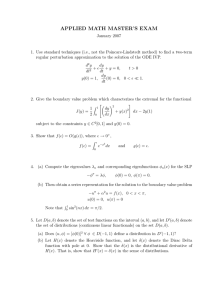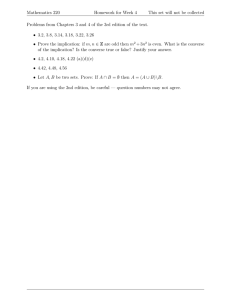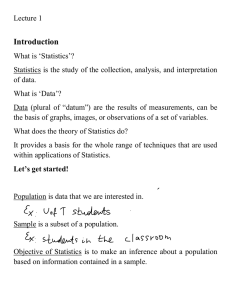A Dictionary for Foundations of Analysis Logic
advertisement
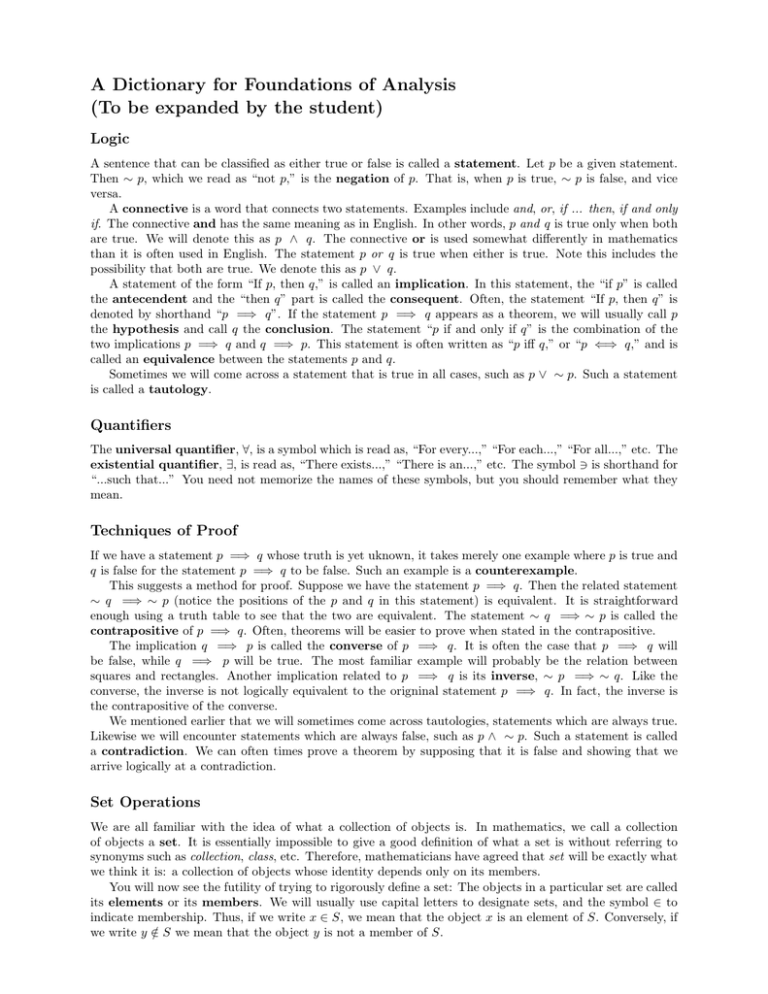
A Dictionary for Foundations of Analysis
(To be expanded by the student)
Logic
A sentence that can be classified as either true or false is called a statement. Let p be a given statement.
Then ∼ p, which we read as “not p,” is the negation of p. That is, when p is true, ∼ p is false, and vice
versa.
A connective is a word that connects two statements. Examples include and, or, if ... then, if and only
if. The connective and has the same meaning as in English. In other words, p and q is true only when both
are true. We will denote this as p ∧ q. The connective or is used somewhat differently in mathematics
than it is often used in English. The statement p or q is true when either is true. Note this includes the
possibility that both are true. We denote this as p ∨ q.
A statement of the form “If p, then q,” is called an implication. In this statement, the “if p” is called
the antecendent and the “then q” part is called the consequent. Often, the statement “If p, then q” is
denoted by shorthand “p =⇒ q”. If the statement p =⇒ q appears as a theorem, we will usually call p
the hypothesis and call q the conclusion. The statement “p if and only if q” is the combination of the
two implications p =⇒ q and q =⇒ p. This statement is often written as “p iff q,” or “p ⇐⇒ q,” and is
called an equivalence between the statements p and q.
Sometimes we will come across a statement that is true in all cases, such as p ∨ ∼ p. Such a statement
is called a tautology.
Quantifiers
The universal quantifier, ∀, is a symbol which is read as, “For every...,” “For each...,” “For all...,” etc. The
existential quantifier, ∃, is read as, “There exists...,” “There is an...,” etc. The symbol ∋ is shorthand for
“...such that...” You need not memorize the names of these symbols, but you should remember what they
mean.
Techniques of Proof
If we have a statement p =⇒ q whose truth is yet uknown, it takes merely one example where p is true and
q is false for the statement p =⇒ q to be false. Such an example is a counterexample.
This suggests a method for proof. Suppose we have the statement p =⇒ q. Then the related statement
∼ q =⇒ ∼ p (notice the positions of the p and q in this statement) is equivalent. It is straightforward
enough using a truth table to see that the two are equivalent. The statement ∼ q =⇒ ∼ p is called the
contrapositive of p =⇒ q. Often, theorems will be easier to prove when stated in the contrapositive.
The implication q =⇒ p is called the converse of p =⇒ q. It is often the case that p =⇒ q will
be false, while q =⇒ p will be true. The most familiar example will probably be the relation between
squares and rectangles. Another implication related to p =⇒ q is its inverse, ∼ p =⇒ ∼ q. Like the
converse, the inverse is not logically equivalent to the origninal statement p =⇒ q. In fact, the inverse is
the contrapositive of the converse.
We mentioned earlier that we will sometimes come across tautologies, statements which are always true.
Likewise we will encounter statements which are always false, such as p ∧ ∼ p. Such a statement is called
a contradiction. We can often times prove a theorem by supposing that it is false and showing that we
arrive logically at a contradiction.
Set Operations
We are all familiar with the idea of what a collection of objects is. In mathematics, we call a collection
of objects a set. It is essentially impossible to give a good definition of what a set is without referring to
synonyms such as collection, class, etc. Therefore, mathematicians have agreed that set will be exactly what
we think it is: a collection of objects whose identity depends only on its members.
You will now see the futility of trying to rigorously define a set: The objects in a particular set are called
its elements or its members. We will usually use capital letters to designate sets, and the symbol ∈ to
indicate membership. Thus, if we write x ∈ S, we mean that the object x is an element of S. Conversely, if
we write y ∈
/ S we mean that the object y is not a member of S.
We can define a particular set in several ways. One method is simply to list the elements of the set.
Thus S = {3, π, a, Saturn} is the set whose elements are the numbers 3 and π, the letter a, and the planet
Saturn. If a set contains a single element, say b, then we write B = {b}. In this way, we have distinguished
the element b from the set {b} containing b as its only element.
If we are discussing infinite sets, it is obviously not possible to simply list all the elements. Therefore,
we will often write down the defining property for the set. For example, the set P = {n : n is prime} is the
set which contains all of the prime numbers.
Okay, now we are ready for some rigorous definitions. Note: when we use “if” in a definition, it is
understood to have the same force as “iff”.
Definition. Let A and B be sets. We say that A is a subset of B (or A is contained in B) if every element
of A is an element of B. We denote this by A ⊆ B (occasionally, we will write B ⊇ A instead of A ⊆ B). If
A ⊆ B and A 6= B then A is called a proper subset of B.
Definition. Let A and B be sets. We say that A is equal to B, written A = B, if A ⊆ B and B ⊆ A.
Although we won’t yet give formal definitions, we will now name some familiar sets.
•
•
•
•
N will denote the set of positive integers (called the natural numbers).
Z will denote the set of all integers.
Q will denote the set of all rational numbers.
R will denote the set of all real numbers.
A very important set in mathematics is the simplest set one can imagine. The empty set, denoted ?,
is the set with no elements. That is, ? = {}. Note that this is a bona fide set since the statement x ∈ ?
can be classified as true or false for every object x. In fact, this statement x ∈ ? is false for every object x.
Theorem. Let A be a set. Then
Proof. To prove that
? ⊆ A.
? ⊆ A, we must show that
x ∈ ? =⇒ x ∈ A.
Since x ∈ ? is false for all x (? has no elements), then the implication is always true according to our
definition of implies.
Definition. Let A and B be sets. The union of A and B (denoted A ∪ B), the intersection of A and B
(denoted A ∩ B), and the complement of B in A (denoted A \ B) are given by
A∪B
=
{x : x ∈ A or x ∈ B}
A∩B
A\B
=
=
{x : x ∈ A and x ∈ B}
{x : x ∈ A and x ∈
/ B}.
If A ∩ B = ?, then A and B are said to be disjoint.
Theorem. Let A, B, and C be subsets of some universal set U (Here U is simply a set which contains the
previous sets). Then the following statements are true:
1. A ∪ (U \ A) = U
2. A ∩ (U \ A) = ?
3. U \ (U \ A) = A
4. A ∪ (B ∩ C) = (A ∪ B) ∩ (A ∪ C) (Distributive Law)
5. A ∩ (B ∪ C) = (A ∩ B) ∪ (A ∩ C) (Distributive Law)
6. A \ (B ∪ C) = (A \ B) ∩ (A \ C)
7. A \ (B ∩ C) = (A \ B) ∪ (A \ C)
Definition. If for each j in a nonempty set J there corresponds a set Aj , then
A
= {Aj : j ∈ J}
is called an indexed family of sets with J as the index set. The union of all sets in
[
{Aj : j ∈ J} = {x : x ∈ Aj for some j ∈ J}.
A
is given by
A
is given by
The intersection of all the sets in
\
{Aj : j ∈ J} = {x : x ∈ Aj for all j ∈ J}.
S
Other notations for {Aj : j ∈ J} include
[
[
Aj and
.
A
j∈J
If J = {1, 2, ..., N }, we may write
n
[
Aj ,
j=1
and if J = N , we will usually write
∞
[
Aj .
j=1
Relations
Definition. (a, b) = {{a}, {a, b}}.
The definition states that the ordered pair (a, b) is a set containing two elements: {a} and {a, b}. Before
you object too strongly to this definition, let’s see that it has the property that we intuitively attribute to
ordered pairs:
Theorem. (a, b) = (c, d) iff a = c and b = d.
Proof. If a = c and b = d, then
(a, b) = {{a}, {a, b}} = {{c}, {c, d}} = (c, d).
Conversely, suppose (a, b) = (c, d). Then, by our definition, {{a}, {a, b}} = {{c}, {c, d}}. We wish to
show that a = c and b = d. There are two cases to consider: a = b and a 6= b. We will consider the first case
and leave the second to the student.
If a = b, then {a} = {a, b}. Thus, (a, b) = {{a}}. Since (a, b) = (c, d), we have
{{a}} = {{c}, {c, d}}.
The set on the left has only one element, thus the set on the right must have only one element. Therefore,
{c} = {c, d}. We conclude that c = d. But then {{a}} = {{c}}, so {a} = {c} and a = c.
Definition. If A and B are sets, then the Cartesian product (or cross product) of A and B, written
A × B, is the set of all ordered pairs (a, b) such that a ∈ A and b ∈ B. Symbolically,
A × B = {(a, b) : a ∈ A and b ∈ B}.
Definition. Let A and B be sets. A relation between A and B is any subset R of A × B. We say that
a ∈ A and b ∈ B are related by R if (a, b) ∈ R, and we will often write this as “aRb”. If B = A, then we
speak of a relation R ⊆ A × A being a relation on A.
Definition. A relation R on a set S is an equivalence relation if it has the following properties for all
x, y, z ∈ S:
1. xRx (Reflective Property).
2. If xRy, then yRx (Symmetric Property).
3. If xRy and yRz, then xRz (Transitive Property).
